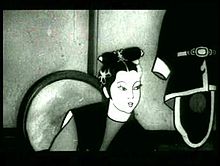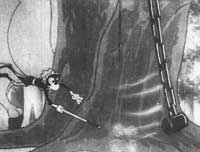This article has multiple issues. Please help improve it or discuss these issues on the talk page. (Learn how and when to remove these messages)
|
| Princess Iron Fan | |
|---|---|
 | |
| Directed by | |
| Produced by | |
| Distributed by | Cinema Epoch |
| Release date |
|
| Running time | 73 min |
| Country | China |
Princess Iron Fan (traditional Chinese: 鐵扇公主; simplified Chinese: 铁扇公主; pinyin: Tiě shàn gōngzhǔ), is the first Chinese animated feature film. It is also considered the first Asian animated feature film. The film is based on an episode of the 16th-century novel Journey to the West. It was directed in Shanghai under difficult conditions in the thick of World War II by Wan Guchan and Wan Laiming (the Wan brothers) and was released on November 19, 1941.
The film later became influential in the development of East Asian animation, including Japanese anime, Vietnamese animation, Korean animation and Chinese animation.
Plot
The story was liberally adapted from a short sequence in the popular Chinese novel Journey to the West. Princess Iron Fan is a main character.
Specifically, the film focused on the duel between the Monkey King and a vengeful princess, whose fan is desperately needed to quench the flames that surround a peasant village.
Creators
| English Production | Original Version | Crew | Romanized |
|---|---|---|---|
| Produced by | 監製 | S.K Chang (Zhang Shankun) | 張善琨 |
| Screenplay by | 編劇 | Wang Qianbai | 王乾白 |
| Screenwriting Consultant | 顧問 | Chen Yiqing | 陳翼青 |
| Sound Recorded by | 錄音 | Liu Enze Using Chinatone Technology |
劉恩澤 採用中華通錄音機 |
| Musical Director | 音樂指揮 | Huang Yijun | 黃貽鈞 |
| Musical Consultant | 音樂顧問 | Zhang Zhengfan | 章正凡 |
| Composer | 作曲 | Lu Zhongren | 陸仲任 |
| Sound Effects | 效果 | Chen Zhong | 陳中 |
| Editing | 剪輯 | Wang Jinyi | 王金義 |
| Printing | 洗印 | Xu Hexiang Lin Xiangfu Chen Xinyu |
許荷香 林祥富 陳鑫甫 |
| Designers | 設計 | Chen Qifa Fei Boyi |
陳啟發 費伯夷 |
| Photography | 攝影 | Liu Guangxing Chen Zhengfa Zhou Jiarang Shi Fengqi Sun Feixia |
劉廣興 陳正發 周家讓 石鳳岐 孫緋霞 |
| Backgrounds | 背景 | Cao Xu Chen Fangqian Tang Tao Fan Manyun |
曹旭 陳方千 唐濤 范曼雲 |
| Illustrators | 繪稿 | Yu Yiru Li Yi Liu Wenjie Wu Guang Yin Fusheng Chen Jintao Xie Minyan Liu Chenfei Zhao Fengshi Zhu Yong Liu Yimeng Shen Youming Hu Sixiao Guo Ruisheng Wu Yan Jin Fangbin Cao Zhong Zhang Danian |
羽翼如 李毅 劉文頡 吳光 殷復生 陳錦濤 謝敏燕 劉嗔非 趙逢時 朱湧 劉軼蒙 沈叩鳴 胡斯孝 郭瑞生 吳焱 金方斌 曹忠 張大年 |
| Line Drawings | 繪線 | Chen Min Wu Minfa Sun Xiuping Yu Wenwang Wu Yueting Huang Zhenwen Lu Zhongbo Dai Jue Ye Lingyun Zhang Liangqin Sun Song Guo Hengyi Yuan Yongqing Shen Ruihe Chen Jinfan Zhang Jutang Fang Pinying Yu Zupeng Sheng Liangxian Shen Zhongxia Tang Yude Lu Guangyi Zhang Tan Zhu Shunlin Ding Baoguang Shi Fakang Zhao Shengzai Qin Qixian Yang Jinxin Feng Bofan |
陳民 吴民發 孫修平 俞文望 吳悅庭 黃振文 陸仲柏 戴覺 葉凌雲 章亮欽 孫松 郭恆義 袁永慶 沈瑞鶴 陳錦範 張菊堂 方品英 俞祖鵬 盛亮賢 沈忠俠 唐秉德 陸光儀 張談 朱順麟 丁竇光 石發康 趙盛哉 欽其賢 楊錦新 馮伯富 |
| Color Artists | 者色 | Yuan Huimin Weng Huanbo Ge Yongliang Wang Zengting Wang Congzhou Quan Han Lin Kezhen Li Shifen Mi Longnian Yuan Yuyao Yuan Zichuan Xu Huifen Zou Guiying Xu Huilan Chen Huiying Cai Yongfa Dai Keshu Dai Kehui Luo Zong |
袁慧敏 翁煥伯 戈永良 王增庭 王從周 全漢 林可珍 李世芬 宓龍年 袁玉瑤 袁子傳 許惠芬 鄒桂英 許蕙蘭 陳慧英 蔡永發 戴克淑 戴克惠 羅粽 |
| Lead Artists | 主繪 | Wan Laiming Wan Guchan |
萬籟鳴 萬古蟾 |
Background

The Wan family twins Wan Laiming and Wan Guchan with their brothers Wan Chaochen and Wan Dihuan were the first animators in China. After the release of their first "real" cartoon, Uproar in the Studio (1926), they continued to dominate China's animation industry for the next several decades. In the late 1930s, with Shanghai under Japanese occupation, they began work on China's first feature-length animated film. In 1939, the Wan brothers saw Snow White and the Seven Dwarfs and set the standard in attempting to create a film of equal quality for the nation's honor.
The film took three years, 237 artists and 350,000 yuan to make. Rotoscoping was used extensively to save money, and the eyes of the live actors are often visible in the faces of the animated characters.
By 1940, the film would render past 20,000 frames, using up more than 200 thousand pieces of paper (400ream=500×400). They shot over 18,000 ft (5,500 m) of footage. And the final piece would contain 7,600 ft (2,300 m) of footage which can be shown in 80 minutes. The Wan brothers also invited the following actors and actresses for sound dubbing (白虹),(严月玲),(姜明),(韩兰根),(殷秀岑). At the time, they were at the Xinhua Film Company animation department since it was the only remaining production company left during the period of the Japanese occupation. The manager of the company who help financed the film was Zhang Shankun.
Princess Iron Fan became the first animated feature film to be made in China. Upon completion the film was screened by the Chinese union film company.
Influence
Princess Iron Fan's influences were far-reaching; it was swiftly exported to wartime Japan, inspiring the 16-year-old Osamu Tezuka to become a comics artist and prompting the Japanese Navy to commission Japan's own first feature-length animated film, 1945's Momotaro's Divine Sea Warriors (the earlier film Momotaro's Sea Eagles is three minutes shy of being feature-length).
See also
- History of Animation
- History of Chinese Animation
- Chinese Animation
- List of animated feature films
- List of films in the public domain in the United States
References
- ^ "An Animated Wartime Encounter: Princess Iron Fan and the Chinese Connection in Early Japanese Animation". Reischauer Institute of Japanese Studies, Harvard University. Archived from the original on 1 March 2019.
Specifically, it focuses Princess Iron Fan (1941), the first animated feature film made in China and Asia, and how its wartime travel to Japan gave rise to the birth of animated feature films in wartime Japan. It also impacted Tezuka Osamu (1928-1989), the so-called god of modern Japanese manga and anime whose works were shadowed by Princess Iron Fan from the beginning to the end of his career. Princess Iron Fan transformed the early history of Japanese animation, yet its national identity was changed by the journey.
- "Princess Iron Fan". Far East Film Festival.
China's first feature-length cartoon, the third in the world, exerted an incredible influence on the Asian animation market.... It also inspired the Japanese to make their own animated feature, indirectly pollinating the early anime industry. PRINCESS IRON FAN was cited as a major influence on Japan's greatest manga artist Osamu Tezuka, who entered the field after seeing it as a boy in 1943.
Further reading
- Jonathan Clements. (2002). "Chinese Animation". Nickelodeon Magazine.
- Travel Channel China. (2004). "Extensive Info on Wan Brothers". Tieshangongzhu first-length cartoon.
External links
- Princess Iron Fan (1941) with English subtitles translated by Christopher Rea, Chinese Film Classics Project (UBC)
- Princess Iron Fan at IMDb
- Princess Iron Fan is available for free viewing and download at the Internet Archive
- Princess Iron Fan is available for free viewing and download at the Internet Archive (another version)
- Completed English subtitles for the film
- A few stills from the movie